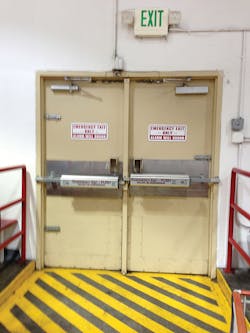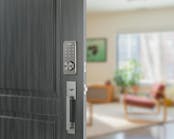Locksmiths can provide their customers with several types of door protection, depending on the application, the location and the customers’ input. Door reinforcements can be installed to resist unauthorized entry. To resist forcible entry on existing lockable doors and gates, customers can be upgraded with security strike plates, knob protection, hinge pins and latch protection.
Another area of door protection is to literally protect the door, jamb and locking hardware from carts, hand trucks and other movable units that can cause damage. Protecting the door can save a facility a significant amount of money, as a fire rated opening that is damaged often must be replaced. An example, a fire rated wood door that has the edge split because of repeated collisions must be replaced. Part of the replacement process is to have the opening inspected in order to be re-certified.
For this article, we will briefly discuss resisting forcible entry and spend the majority of the article on protecting the door, jamb and hardware.
Resisting Forced Entry
There are three basic ways a locksmith can improve resistance against forcible entry. These include adding protection to strike plate area, the latch/bolt and lock areas and the hinged side of the door.
Security Strike Plates: Protection can be added to the strike plate area of inswing doors by installing a security strike plate. Security strike plates are normally installed into wooden jambs to prevent forcibly breaking the jamb in order to gain access. This oversized strike plate strengthens the jamb because of the increased length and additional mounting screws to secure the plate onto the jamb. The length of security strike plates range from about four or five inches to 18 inches or even longer.
Strike plates are normally made of 13 gauge or thicker steel in a variety of finishes. Single and double-hole versions are available. Single-hole models will normally have a center hole. Some security strike plates even have built-in dust boxes. Most double hole security strike plates will have a 3-5/8", 4" or 5-1/2" center-to-center dimension. These are the common spacings for most interconnected locks.
When installing a security strike plate , an important consideration is the length of screws. Most homes, apartments and condominiums have a ¾" inch thick wood door jamb that is mounted onto a series of 2x 4s. Often, there are spacers between the jamb and the wood framing to ensure the door jamb legs are plumb. Mounting screws should go through the jamb and into at least the first 2x 4. Use 3-1/2" or longer wood screws to install a security strike plate to be certain the screws go completely through the jamb and securely mount into the wood framing. To avoid breaking screws as they are being installed, drill full depth pilot holes.
Suggestion: If the latch side door gap is larger that 3/16", you may want to surface mount the security strike plate, if the opening is not fire rated. Surface mounting the security strike plate provides a higher level of security by reducing the gap.
Latch Protection: Installing latch protection limits access to the area surrounding the latch or bolt. Latch protection is available for outswing and inswing wood, hollow metal and aluminum glass doors. For inswing doors, interconnecting metal parts are mounted onto both the door and the jamb. For outswing doors, there is latch protection only or latch protection plates cover part or most of the lock mechanism.
Hinge Pins: Hinge pins are installed onto outswing doors to prevent the door from being removed from the jamb by pulling the pins from the hinges or cutting the knuckles off. A hinge pin has wood screw threads on one end and the other end extends from the head in the shape of an unthreaded screw. The top of the hinge pin has a slot to accommodate a screwdriver for installation.
To install a hinge pin, remove one screw from each leaf that is directly opposing each other. Thread in the hinge pin. When the door closes, the exposed end of the hinge pin should slide into screw hole. Use a slightly larger drill bit and enlarge the opening. For most residential applications, standard butt hinges require a #10 screw. For most commercial applications, conventional butt hinges require a #12 screw.
As an alternative to hinge pins, hinge manufacturers offer butt hinges with a stud extending from one leaf and a receiving hole in the other. When the door is closed, the stud extends into the receiving hole.
Door Protection
There are a number of ways to protect doors from accidental abuse as well as the damage that can be caused by day-to-day operation. These can include door face protection plates, door angle plates, door edge plates, jamb corner guards, wrap around plates, push plates with access holes for locks and lock hardware protection.
If the door has been mis-drilled, retrofit with a different lock or has sustained some damage, wrap around plates and push plates can add protection to the door.
Door face protection plates are installed onto the exposed side of the door face, the door face and one edge, the door face and two edges and both door faces and the bottom edge.
There are four categories of door face protection plates: mop plates, kick plates, stretcher plates and armor plates. Mop plates, kick plates and armor plates are mounted just above the bottom of the wood and hollow metal door. Stretcher plates are designed to protect a specific height area on the face of the door where consistent contact is made by gurneys, service carts or similar equipment.
Mop plates are less than eight inches tall; kick plates are eight to 16 inches tall; armor plates are 26 to 48 inches tall and stretcher plates range from six to eight inches. These plates are available in 1/8" thick high impact polyethylene or .038" or thicker brass, aluminum and stainless steel. Finish options for polyethylene are clear or black. Depending upon the opening, door protection plates can be mounted using screws, double sided tap or adhesive.
According to the NFPA 80, 2007 Edition Annex E.3: "Protective plates are usually utilitarian in nature and are used to provide additional resistance to wear or impact. Protective plates are usually flat sheets of metal or plastic applied on one or both door faces and located within the lower 16 in. (406 mm) of the door. Plates above this height could affect the fire performance of the door but can be permitted to be used if tested and approved."
On fire rated openings, a UL Listed mop plate can be six inches tall and a kick plate can be 10 inches tall. For UL Listed armor plates, the option is up to 48 inches high. The plates must be a minimum of .050" thick and stainless steel for UL and Warnock Hersey Listed Products up to 3 hours rating on steel fire doors and frames. These plates must be two inches less than door width when installed onto the push side and 1-1/2" less than door width when installed onto the pull side of the door. Most protection plates have beveled edge as standard. They are installed using screws.
Door angle plates wrap around one or both sides or the bottom to provide additional protection. These plates are normally mounted low on the door. They can be custom ordered with cutouts for flush bolts, hinges, and locks.
Door edge plates for the latch side and the hinge side of the door come in varying materials and thicknesses. On non-fire rated openings, edge plates can cover any area desired. Fire rated door edge plates must be of specific dimensions with specific mounting instructions. All Listed plates for fire rated openings must have a listing company label stamped into the plate.
Protectors attempt to prevent damage to exposed lock hardware such as exit device end caps, surface vertical rods and latches, and lever handles. These lock hardware protectors are mounted onto the face of the door, over the hardware to be protected, between the hardware and the hinge edge of the door or below the hardware.
Trim protector bars are available for knob and levers and exit devices including end caps. Rockwood Manufacturing Company sells solid, stainless steel trim protectors to provide solutions to door and trim damage. There are general "U" shaped protectors, ramped protectors and protectors designed to enclose exit device end caps and a portion of the rail assembly. Trim protectors are designed to be mounted using 10-24 sex bolts requiring 5/16" diameter cross bore openings.
Don-Jo Mfg., Inc., sells stainless steel vertical rod and latch protectors, including rod covers and left or right hand reverse door latch protectors. They are installed over the bottom rod and latch of a surface-mounted vertical rod exit device at the base of the door to deflect traffic. The rod cover is 24" tall and the latch bolt covers are 10" tall, sufficient to cover the latch bolt and the lower portion of the vertical rod assembly. The handed latch guard protectors are constructed of .062" stainless steel and have a 45-degree angled vertical ramp along the swing side of the door.
The Americans With Disabilities Act (ADA) requires 32" minimum clear space, measured from the open door to the opposite frame. The vertical rod latch bolt cover has a 2-1/8" projection. This measurement must be taken into consideration to maintain the 32" minimum clear space.
Reminder: Before installing door hardware onto a fire rated opening, when in doubt, contact your local Local Authority Having Jurisdiction.
For more information, contact your local locksmith distributor. The following list is a sampling of the manufacturers whose companies provide different forms of door protection.
Don-Jo: www.don-jo.com
Hager Companies: www.hagerco.com
Major Mfg: www.majormfg.com
Markar: www.markar.com
Pro-Lok: www.pro-lok.com
Rockwood Manufacturing Company: www.rockwoodmfg.com
Securitech: www.securitech.com/
Trimco: www.trimcobbw.com






